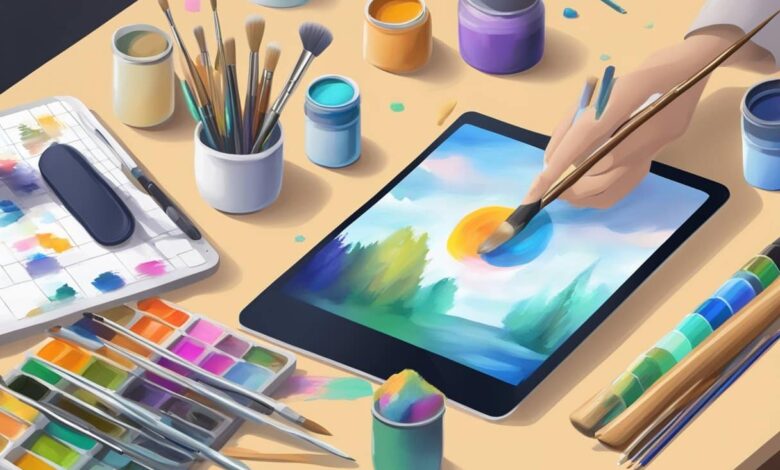Mastering Digital Illustration: Essential Skills for Modern Artists

The art world experienced a transformation through digital illustration because artists gained enhanced precision and flexibility alongside the ability to break artistic limits. Every digital beginner who moves from traditional art to digital must learn essential skills.
The Digital Illustration Course builds the abilities of aspiring artists by teaching technical expertise and advancing their creative imagination in combination with industrial skills.
Why Learn Digital Illustration?
The expanding digital media sector has created a new demand for skilled illustrators who work in entertainment, advertising ventures, gaming, and the publishing industry. The creative process becomes simplified through digital art because artists gain easy access to multiple layers and tools that help them easily modify their work.
Students who engage in Digital Illustration Courses gain professional tools and design software experience through a planned academic program. Digital illustration skills are essential for all artists seeking to become concept artists, children’s book illustrators, or game designers among contemporary art professionals.
Essential Skills for Mastering Digital Illustration
1. Understanding Digital Tools and Software
The initial stage of digital illustration mastery includes knowledge of standard software parts, including:
- Adobe Photoshop provides the best capabilities for digital creation through painting and texturing and advanced editing capabilities.
- Adobe Illustrator is the best for vector-based illustrations, logos, and clean-line artwork.
- Corel Painter mimics traditional painting techniques with natural brushes.
- Procreate is the top selection among digital artists who utilize iPads because of its user-friendly interface and advanced capabilities.
A Digital Illustration Course trains students to handle these programs with excellence through shortcut strategies and introduces different brush collections to generate professional artwork.
2. Mastering Digital Brushes and Textures
Digital illustrators need to develop skills in digital brush usage, which includes understanding brush selection and customization because this matches the traditional practice of artists selecting proper brush tools for their work.
Your artistic development will gain realism and impact by mastering adjustments of these digital art functions: pressure sensitivity, opacity, blending modes, and texture mapping.
Students learn brush techniques through practical training in digital courses so they can create distinctive artwork by modifying digital brushes and textures.
3. Sketching and Line Art Techniques
Any illustrator needs to develop strong basic drawing abilities to succeed. Digital art relies on line art elements for defining expressive shapes alongside depicting motions through expressions.
Mastering:
- Gesture drawing involves creating quick, expressive sketches portraying motion and shapes.
- Deepness emerges when you combine thick lines with thin lines to establish emphasis.
- –Perspective and Proportions – Ensuring accurate spatial representation.
A Digital Illustration Course will teach these basics through direct exercises that help students develop their sketching capabilities.
4. Understanding Color Theory and Lighting
The distinction between moods and the power of storytelling comes from color, while the visual appeal also depends on it. The mastery of digital illustration requires artists to learn certain essential principles.
- You should use the three color schemes, complementary, analogous, or triadic, to achieve effective color harmony in your artwork.
- Depth development occurs through properly applying shadows and highlights during visual creation.
- Artists achieve high-quality work through the use of blending techniques to transition colors between different parts of their artwork smoothly.
Digital courses demonstrate systematic training on how color palettes, together with lighting techniques and gradients, enhance illustrations.
5. Layer Management and Non-Destructive Editing
Working on digital illustrations with layers stands as one of their primary benefits. Proper layer management helps artists:
- Users can make modifications without destroying the original artwork components.
- Users can implement adjustment layers as non-destructive color correction tools that maintain the integrity of original art content.
- The courses teach ideal approaches for building layers as well as masking and smart object management.
6. Composition and Storytelling in Illustration
Great illustrators combine their mastery of technical abilities with complete knowledge of how to construct and narrate visually. Leadership through artwork visualization occurs through specific techniques such as:
- Visual elements achieve balance through the application of The Rule of Thirds in proportionate arrangements.
- Visual attention leads toward important aspects of illustrations through the use of Focal Points.
- Dynamic Posing – Enhancing character expressions and emotions.
An organized Digital Illustration Course trains students on how to build better storytelling methods, which leads to more effective imagery.
7. Character and Environment Design
Digital illustrators frequently create characters with their backgrounds while working on animation projects as well as games and comic work. This requires:
- Anatomy and Expression – Capturing lifelike poses and emotions.
- Artists can use clothing accessories to decorate characters with unique costumes and props.
- Digital artists must develop immersive settings that have extensive characteristics and substantial particulars known as World-Building.
The educational curriculum provides hands-on training, which includes character model development and environment planning techniques as well as complete scene unity concepts.
8. Adapting to Industry Trends and Professional Workflow
Digital art evolves quickly due to current industry changes, such as AI-based tools combined with 3D modeling software, which continues to introduce updated features for efficient workflows. Aspiring digital artists must:
- Students should maintain knowledge about modern tools and creative methods.
- One should produce a professional portfolio that displays various artistic styles within it.
- Students learn the professional approach to service client needs and handle revision requests in this discipline.
Accomplished artists through Digital Illustration Courses, learn how to develop professional portfolios alongside obtaining advice about industry trends that prepare them for future career opportunities.
How to Choose the Right Educational Institution
Identify courses for Digital Illustration based on these factors:
- The learning program must contain essential techniques together with industry trends and software capabilities.
- The expertise of the teaching staff must be evaluated before enrolling. The training includes practical projects along with assignments that require feedback and input from instructors.
- Are there online and self-paced options available?
MAGES Institute acts as the solution point. The available digital illustration courses at our institution support students in reaching their educational targets.
Conclusion
Students need solid technical skills along with imagination capabilities combined with ongoing education when learning digital illustration. Digital Illustration Courses provide artists with organized education alongside practical work opportunities alongside professional industry knowledge.
Strong familiarity with digital illustration techniques enables you to pursue an endless variety of career paths which include gaming as well as animation publishing and marketing fields. Begin your digital illustration path right now to achieve your complete potential in this field.




